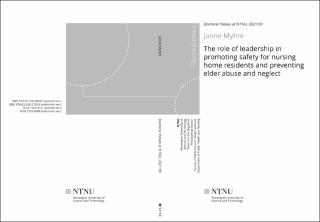| dc.contributor.advisor | Nakrem, Sigrid | |
| dc.contributor.advisor | Saga, Susan | |
| dc.contributor.advisor | Malmedal, Wenche Karin | |
| dc.contributor.advisor | Ostaszkiewicz, Joan | |
| dc.contributor.author | Myhre, Janne | |
| dc.date.accessioned | 2021-06-03T08:37:15Z | |
| dc.date.available | 2021-06-03T08:37:15Z | |
| dc.date.issued | 2021 | |
| dc.identifier.isbn | 978-82-326-5730-8 | |
| dc.identifier.issn | 2703-8084 | |
| dc.identifier.uri | https://hdl.handle.net/11250/2757497 | |
| dc.description.abstract | This thesis describes the phenomenon of elder abuse and neglect in the institutional context from the perspective of nursing home leaders. Elder abuse and neglect in nursing homes is a complex multifactorial problem and entails various associations across personal, social, and organizational factors. One -way leaders can prevent abuse and neglect and promote quality and safety for residents is to follow up on any problems that may arise in clinical practice in a way that facilitates staff learning. How nursing home leaders follow up and what they follow up on might reflect their perceptions of abuse, its causal factors, and the prevention strategies used in the nursing home. At the same time, descriptions, perceptions, and understandings around the concept of elder abuse and neglect in nursing homes vary in different jurisdictions as well as among healthcare staff, researchers, family members, and residents themselves. Different understandings of what constitutes abuse and neglect and its severity complicate identification, reporting, and managing the problem.
To address the knowledge gap outlined above, the aim of this thesis is to explore the role of leadership in patient safety concern related to elder abuse and neglect. Knowledge about nursing home leaders’ perceptions of elder abuse, their experiences of barriers and enablers to reporting elder abuse and neglect, and how the leaders follow up on reports and information are essential because their understanding of the phenomenon will influence what they signal to staff as important to report and what they investigate to create a safe and healthy environment for both residents and staff. The specific objectives were to explore:
• How nursing home leaders perceive elder abuse and neglect;
• What nursing home leaders experience as barriers and enablers to reporting elder abuse and neglect; and
• How nursing home leaders follow up on information and reports of elder abuse and neglect.
The research method and design were qualitative and explorative, including both focus group interviews with care managers and individual interviews with nursing home directors. A total of 43 participants from six different municipalities and 21 nursing homes were included.
A core finding was a lack of awareness about the concept of elder abuse and neglect. Keywords from the categorization of abuse helped the participants to reflect upon the topic and revealed examples of events they interpret as being harmful or distressful to residents. At the same time, our findings revealed an ambiguity in the nursing home leaders’ examples. While, on one hand, they described the situation as harmful, on the other hand, they rationalized and attempted to provide excuses for why it was happening. The ambiguity in the nursing home leaders’ examples can be viewed as an attempt to adapt to internal and external demands by rationalizing abuse and diminishing personal and professional accountability.
The nursing home leaders in our study experienced difficulties obtaining information related to abuse and neglect within the nursing homes because of structural factors related to the organization, cultural factors, and abuse severity factors. Because of difficulties obtaining information from the formal reporting system, nursing home leaders have to adjust and find other ways to obtain information such as reading the nursing notes in the electronic patient record system and using an informal reporting system, including information provided verbally by staff and through observation. Nursing home directors expressed a more positive view of the usefulness of the formal reporting system than care managers did. Generally, the follow-up on reports and various information leaders receive is linked to the belief that patient safety can be improved by learning from incidents and “near misses”
Our findings revealed that nursing home directors and care managers differ in their beliefs about the root causes of elder abuse. A felt powerless within the leaders in terms of being able to follow up on all levels, and a lack of evaluation tools was seen as a barrier to facilitating patient safety and systematic organizational learning. The leaders’ attempts to adapt both internal and external demands could be seen in their reliance on a linear personal approach rather than a system approach when they followed up on abuse and neglect within the nursing home context. | en_US |
| dc.language.iso | eng | en_US |
| dc.publisher | NTNU | en_US |
| dc.relation.ispartofseries | Doctoral theses at NTNU;2021:99 | |
| dc.relation.haspart | Paper 1: Myhre, Janne; Saga, Susan; Malmedal, Wenche Karin; Ostaszkiewicz, Joan; Nakrem, Sigrid. Elder abuse and neglect: an overlooked patient safety issue. A focus group study of nursing home leaders’ perceptions of elder abuse and neglect. BMC Health Services Research 2020 ;Volum 20.(199) s. 1-14 | en_US |
| dc.relation.haspart | Paper 2: Myhre, Janne; Malmedal, Wenche Karin; Saga, Susan; Ostaszkiewicz, Joan; Nakrem, Sigrid. Nursing home leaders’ perceptions of factors influencing the reporting of elder abuse and neglect: a qualitative study. Journal of Health Organisation and Management 2020 ;Volum 34.(6) s. – Not included due to copyright restrictions. Available at: http://dx.doi.org/10.1108/JHOM-02-2020-0031 | en_US |
| dc.relation.haspart | Paper 3: Myhre, Janne; Saga, Susan; Malmedal, Wenche Karin; Ostaszkiewicz, Joan; Nakrem, Sigrid. React and act: a qualitative study of how nursing home leaders follow up on staff-to-resident abuse. BMC Health Services Research 2020 ;Volum 20.(1) s. - | en_US |
| dc.title | The role of leadership in promoting safety for nursing home residents and preventing elder abuse and neglect | en_US |
| dc.type | Doctoral thesis | en_US |
| dc.subject.nsi | VDP::Medisinske Fag: 700 | en_US |

